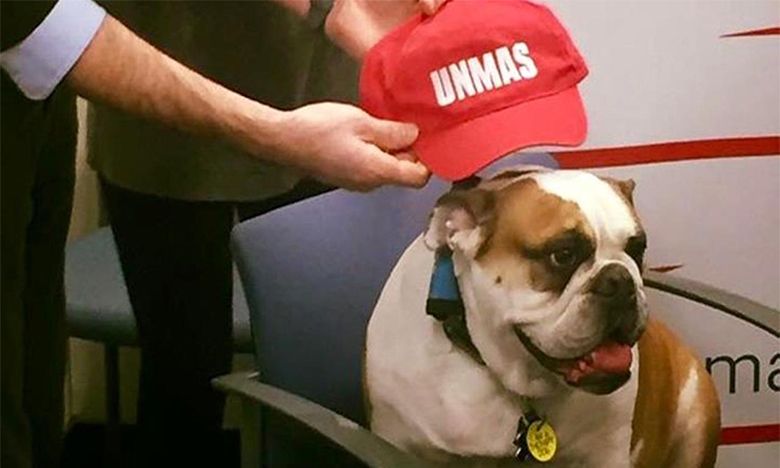It’s just after noon at the United Nations Staff Counsellor’s Office, and Chloe, the resident therapy dog, has already earned her keep — as well as that office catnap, er, pup-nap.
Since Chloe’s arrival that morning, some 10 U.N. staffers have received a quick nuzzle or kiss from the 5-year-old English bulldog, who wags her bottom half with abandon as she waddles over to greet new arrivals. While it might be a stretch to say that Chloe is more popular than the new secretary-general António Guterres, since her introduction to the U.N. in early February, she has been booked solid, visiting more than 300 employees around the Secretariat campus, during open office hours or just saying hello to stragglers who swing by hoping for a bit of C-time.
Chloe’s presence at the U.N. isn’t frivolous, argues Dawn Straiton, chief of the U.N. Staff Counsellor’s Office and a psychiatric nurse practitioner. Straiton is Chloe’s owner and handler, and handles almost all of the associated costs. According to a 2013 report commissioned by the United Nations High Commissioner for Refugees on its mental health and psychosocial support, 19 percent of international aid workers described clinically significant post-traumatic stress disorder symptoms. The same report indicated that 46 percent of repatriated international staff — which describes many staffers at the U.N. headquarters — suffered from moderate or high levels of PTSD symptoms, which can persist for years after field postings in high-stress environments.
“A therapist is good, but sometimes, especially when I’m busy with work, I want to clear out my head, but not by talking it out,” says Christiaan Lampinen, an editorial assistant with the U.N. Department of Public Information whose office is on the list for a Chloe visit.
A 2014 study, “Are Therapy Dogs Like Xanax?”, published in the journal Anthrozoös, asked participants to write about traumatic situations. Those who did so in the presence of a therapy dog exhibited less distress than those in a room without one. Those with a dog present also showed significant decreases in depressive symptoms after the task. For delegates from far-flung countries who often work without family, friends or pets nearby while juggling starvation prevention in Yemen and engaging nuclear North Korea, Chloe is a welcome respite.
A GOOD THERAPY DOG MUST BE CHEERY, FRIENDLY AND ABLE TO GET ALONG WITH ALL SORTS OF PEOPLE — IN OTHER WORDS, THEY NEED TO OUTSHINE EVEN MOST DIPLOMATS.
Animals have been used in health care as far back as 1792 — in the late 1800s, Florence Nightingale wrote about using small animals in the treatment of isolated patients. Disaster Stress Relief Dog teams have responded to the aftermath of tornadoes in Oklahoma, the shootings in Newtown, Connecticut, and even at the U.S. Embassy in Nairobi. The field of animal-assisted therapy has become increasingly normal in therapeutic care over the past decades. “Thirty years ago, you would seldom hear of an animal program at a nursing home, and now you seldom hear of a nursing home without one,” says Alan Beck, director of the Center for the Human-Animal Bond at Purdue University and a pioneering researcher who helped establish the field of anthrozoology. It’s the same, he says, for child therapists.
But Beck and other therapists caution that animals’ primary purpose, especially in counseling sessions, is almost always used to “set the mood” for other interventions. The animal itself isn’t therapy, Beck says — rather, the animal functions as an aide to help the patient reach a calm state.
In the face of the Trump presidential administration, with U.N. Ambassador Nikki Haley charged with representing Donald Trump’s interests at the U.N. Security Council and other pressing meetings, Chloe could offer some calm to an international Secretariat staff who aren’t all on board with the changes — like a possible 40 percent cut in voluntary funding for key U.N. agencies, including UNICEF and the World Food Program. Add that to the normal melee of working in one of the world’s foremost governmental bodies, not to mention the scandals over the oil-for-food program and alleged sexual abuse by U.N. peacekeepers.
Ah, but Chloe is blissfully unaware of such global chaos! From an early age, Chloe was “playful and gentle” says Straiton, who adopted Chloe at the age of 3 months and regularly brought the dog to visit her father, a dementia patient at a veterans’ nursing home. Encouraged by patients and doctors, Straiton took Chloe to train as an official therapy dog — the course ensured she was ready to be petted, to meet other dogs and play nicely and to cozy up properly to kids, among other skills. A good therapy dog must be cheery, friendly and able to get along with all sorts of people — in other words, they need to outshine even most diplomats.
For the most part, the buttoned-up, well-attired staffers rushing among their offices and the conference rooms of the Le Corbusier–designed Secretariat Building are fans of Chloe. In an August 2016 survey, 85 percent of respondents said they were “neutral to strongly” supportive of animal-assisted therapy at their U.N. work location. Those who interacted with Chloe reported positive reactions such as increased happiness, decreased pain and reduced anxiety or depression. These effects lasted from a few minutes to a few hours. But as with all U.N. employees, Chloe’s contract is subject to renewal — in her case at the end of July.
And there are some critics. The U.N. should “take into account the larger dysfunction of the organization that actually makes the staff insecure and promotes [an] unhealthy working environment,” argues a political officer with the Department of Peacekeeping Operations, who cannot speak to the press on official matters.
Others would like more. How about some cats, for good measure?

